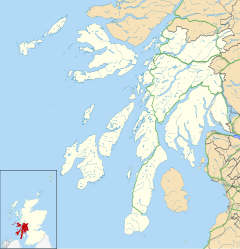Kilmartin
Kilmartin
|
|
|---|---|
 Kilmartin |
|
| Kilmartin shown within Argyll and Bute | |
| OS grid reference | NR 83425 98889 |
| Council area |
|
| Lieutenancy area |
|
| Country | Scotland |
| Sovereign state | United Kingdom |
| Post town | Lochgilphead |
| Postcode district | PA31 |
| Dialling code | 01546 |
| EU Parliament | Scotland |
| UK Parliament |
|
| Scottish Parliament |
|
Kilmartin (Scottish Gaelic: Cille Mhàrtainn) is a small village in Argyll and Bute, western Scotland. It is best known as the centre of Kilmartin Glen, an area with one of the richest concentrations of prehistoric monuments and historical sites in Scotland. It contains over 350 monuments within a 6-mile radius.
Kilmartin Parish Church is a congregation of the Church of Scotland. The present church building was designed by architect James Gordon Davis and opened in 1835, though there had been earlier churches on the site. The churchyard has an important collection of early Christian and medieval carved stones, known as the Kilmartin Stones. Some are displayed within the parish church itself, others have been gathered into lapidaria within the graveyard, others still remain lying within it.
The two most important monuments are the Kilmartin crosses, one 9th-10th century, the other late medieval in date, within the church. In the churchyard are a large collection of late medieval gravestones in the 'West Highland' style, dating between the 14th and early 16th centuries. Many are marked by figures of warriors in contemporary dress with spears and swords, along with figures of fantastic animals, foliage and interlace patterns. None are inscribed, so the identities of the persons commemorated are unknown. They can, however, be taken to be the monuments of the local landowning or minor noble class in late medieval times. Kilmartin Church was evidently an important burial site, and the graveslabs of the 'Loch Awe school' of carving may have been carved in a workshop at or near Kilmartin. The swords shown on many of the stones refer to warrior (or, more broadly, social) status, and have no connection with the Templars or other medieval military orders, as is sometimes suggested. Women are commemorated on some of the stones, their symbol often being the shears (referring to household activities).
Kilmartin House Museum of Ancient Culture is an award winning museum which interprets the monuments of the area for visitors, and has a selection of excavated artefacts of various periods. It is located within the village within a group of converted buildings.
...
Wikipedia

